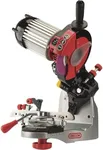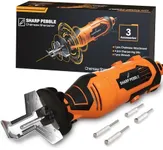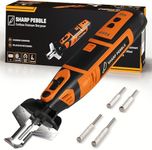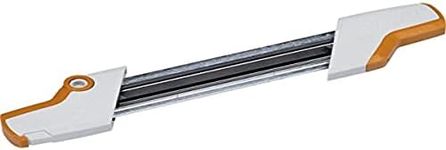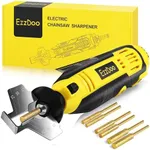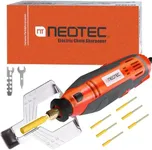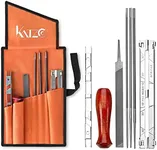Buying Guide for the Best Chainsaw Blade Sharpeners
Choosing the right chainsaw blade sharpener is crucial for maintaining the efficiency and longevity of your chainsaw. A sharp blade ensures clean cuts, reduces the strain on the motor, and enhances safety. When selecting a sharpener, consider the type of chainsaw you have, the frequency of use, and your level of experience with sharpening tools. Understanding the key specifications will help you make an informed decision that best suits your needs.Type of SharpenerThere are different types of chainsaw blade sharpeners, including manual files, electric sharpeners, and bar-mounted sharpeners. Manual files are simple and inexpensive, ideal for occasional use and for those who prefer a hands-on approach. Electric sharpeners are more efficient and suitable for frequent use, offering precision and speed. Bar-mounted sharpeners provide a balance between manual and electric options, offering ease of use and consistency. Choose the type based on how often you use your chainsaw and your comfort level with sharpening tools.
CompatibilityCompatibility refers to whether the sharpener can work with the specific chain pitch and gauge of your chainsaw. It's important because using an incompatible sharpener can damage the chain or result in improper sharpening. Chains come in different pitches (e.g., 3/8 inch, .325 inch) and gauges (e.g., .050 inch, .058 inch). Check your chainsaw's manual or the chain itself for these specifications and ensure the sharpener you choose can accommodate them. This ensures effective sharpening and prolongs the life of your chain.
AdjustabilityAdjustability in a chainsaw sharpener allows you to set the correct angle and depth for sharpening. This is important because different chains require different sharpening angles, typically ranging from 25 to 35 degrees. A sharpener with adjustable settings ensures you can achieve the precise angle needed for your chain, resulting in optimal cutting performance. If you use multiple chains with different specifications, an adjustable sharpener will be more versatile and useful.
Ease of UseEase of use refers to how user-friendly the sharpener is. This is important because a complicated sharpener can be frustrating and time-consuming, especially for beginners. Look for features like clear instructions, ergonomic design, and simple operation. If you're new to sharpening chainsaw blades, a sharpener with straightforward controls and minimal setup will be more beneficial. Experienced users might prefer more advanced features that offer greater control and precision.
DurabilityDurability refers to the build quality and longevity of the sharpener. A durable sharpener is made from high-quality materials that can withstand regular use without wearing out quickly. This is important because a well-built sharpener will provide consistent performance over time and be a better investment. Look for sharpeners made from robust materials like hardened steel or high-grade plastic. If you use your chainsaw frequently, investing in a durable sharpener will save you money and hassle in the long run.
PortabilityPortability refers to how easy it is to transport and use the sharpener in different locations. This is important for users who need to sharpen their chainsaw blades in the field or at various job sites. Portable sharpeners are typically lightweight and compact, making them easy to carry and store. If you often work away from a workshop or need to sharpen your chainsaw on the go, a portable sharpener will be more convenient and practical.
